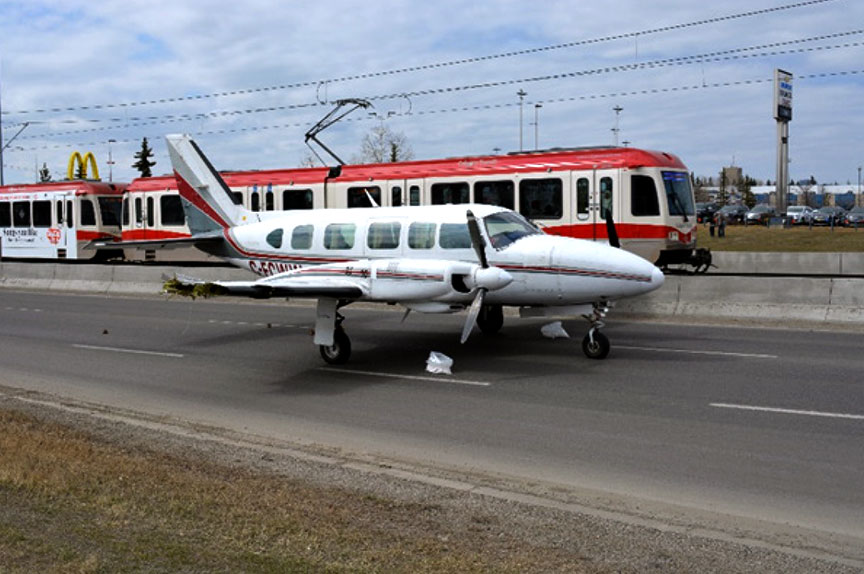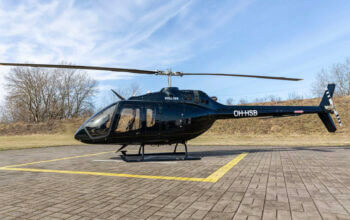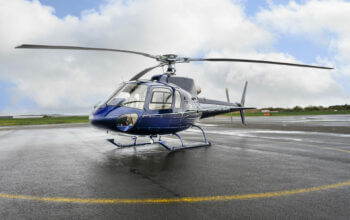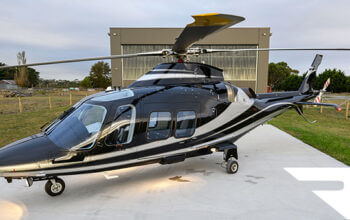Estimated reading time 7 minutes, 2 seconds.
A Piper PA-31-350 Navajo Chieftan’s loss of power and emergency landing on a Calgary roadway has prompted safety warnings from Canada’s Transportation Safety Board (TSB).

The aircraft, operated by Super T Aviation of Medicine Hat, Alta., touched down in the northbound lanes of 36 Street N.E. in Calgary, near Calgary International Airport (YYC), just before 6 a.m. on April 25, 2018.
There were no injuries to passengers, flight crew or anyone on the ground, but the aircraft’s right wing clipped a light standard on the right side of the road, shearing off the outer four feet of the wing, the TSB found.
The incident was photographed and caused a considerable stir on social media and in the mainstream press.
TSB said it conducted a limited-scope, fact-gathering investigation into the incident to “advance transportation safety through greater awareness of potential safety issues.”
HISTORY OF FLIGHT
The aircraft departed Medicine Hat Airport at 4:44 a.m. local time on an instrument flight rules (IFR) flight plan to YYC with two flight crew and four passengers on board for a scheduled charter flight, according to the TSB investigation report.
After climbing to a cruising altitude of 8,000 feet above sea level, the crew completed the cruise checklist, which included switching the fuel selectors from inboard to outboard fuel cells, the TSB said.
A descent began at 5:35 a.m., when the aircraft was about 20 nautical miles southeast of the threshold for Runway 35R at YYC.
At 5:38 a.m., when the aircraft was approximately 12 nautical miles south of Runway 35R, the right engine began to surge, said the report.

The captain then asked the first officer to run the engine failure in-flight checklist and the first officer performed them–with the exception of the cause check and feathering the propeller, said the report.
Among other things, the cause check directs the crew to check fuel flow, fuel quantity and fuel selector position.
At 5:39 a.m., the crew contacted the arrival controller at YYC and said they had lost the right fuel pump, and at approximately 5:40 a.m. the left engine began to surge, according to the report.
The aircraft was transferred to the tower controller at 5:42 a.m., and moments later the flight crew transmitted a Mayday call, the report found.
Though cleared for landing on Runway 35R, the flight crew recognized the aircraft would not make it to the airfield and selected a “suitable road” to attempt an emergency landing.
A second Mayday call followed at 5:43 a.m., informing the tower controller they would be landing on a road. The aircraft touched down on 36 Street N.E., just north of the intersection with Marlborough Drive N.E., and clipped the light standard soon afterward.
The aircraft continued north, through the intersection with Marbank Drive N.E., and came to a stop just south of the on-ramp for eastbound 16 Avenue N.E., which is part of the Trans-Canada Highway, the report said.
The emergency locator transmitter did not activate.
SOPs
Super T Aviation created a standard operating procedures (SOPs) document containing a normal procedure checklist for the PA-31-350, but it differed from the manufacturer’s Pilot Operating Handbook (POH), according to the TSB.
A key difference is the fact the POH descent checklist includes a step to check that the fuel selectors are set to inboard, said the TSB. The operator’s normal procedures descent checklist did not include this item. Instead, the step to check that fuel selectors are set to inboard was included in the before landing checklist.
If outboard fuel cells are used during climbs, descents or prolonged uncoordinated level flight, “power loss may result even if there is appreciable fuel remaining,” the POH notes. This statement was not reproduced in the Super T Aviation normal procedures checklist document, according to the TSB.
FUEL MANAGEMENT
The investigation found the captain and first officer used different methods to manage and monitor fuel consumption throughout the flight.
The captain referenced the global positioning system (GPS), which provides basic fuel-planning data “based on a fuel consumption rate input by the user,” said the TSB.
But the GPS did not have any data input relating to the actual fuel burn, nor did it have any data input about how much fuel was “actually on board the aircraft at a specific time, or in which fuel cell,” said the TSB.
The captain also relied on memory to determine how much fuel was on board and in which fuel cell, and when to switch cells, the TSB found.
The first officer leaned the engines out–changing the fuel mixture fed to the engines–to 22 gallons per hour (per engine) based on the digital fuel flow meter, and incorporated an observation of the fuel quantity gauges in his routine instrument scan, said the TSB.
“The flight crew members did not discuss fuel management strategies during the pre-flight briefing,” the report found.
SAFETY MESSAGES
While the TSB’s mandate is not to assign fault or determine civil or criminal liability, it did issue safety messages as part of its investigation report.
“As shown in this occurrence, when fuel management SOPs are not in place, fuel starvation can occur even if there is sufficient fuel remaining on board the aircraft to complete the planned flight,” said the report.
“In addition, if flight crews do not complete checklist procedures in their entirety, opportunities to rectify emergency situations can be lost.
“However, in this occurrence, when the flight crew decided that the aircraft could not make it to the airport, their prioritization of selecting a suitable alternate landing area and managing the energy state of the aircraft contributed to the success of the emergency landing.”
The full TSB report is available here.








